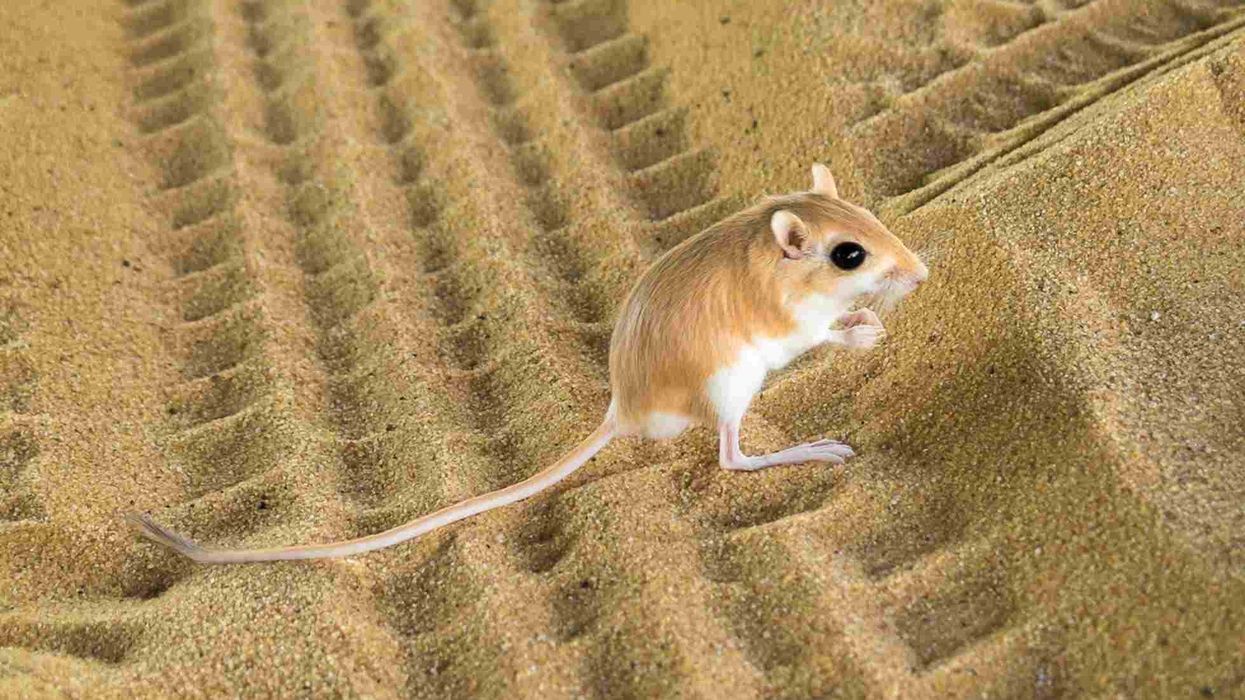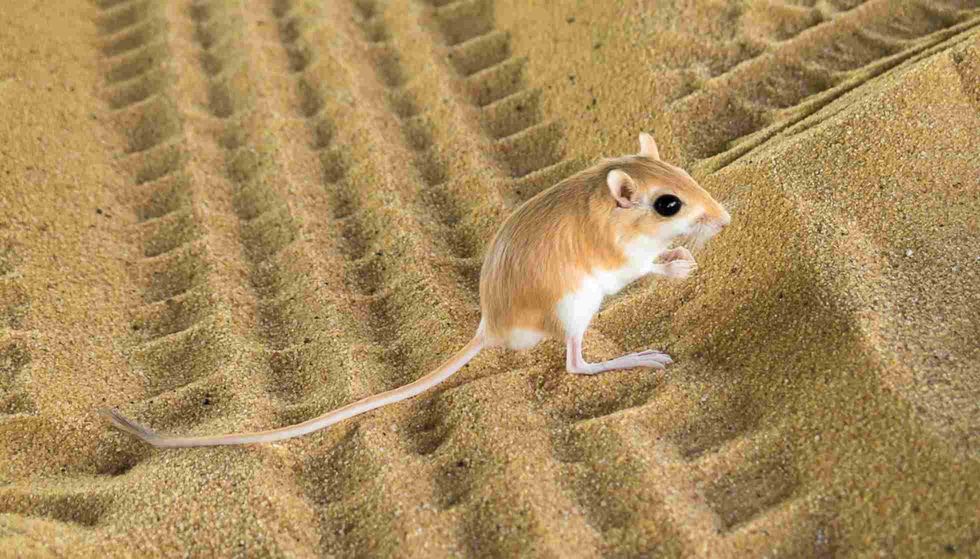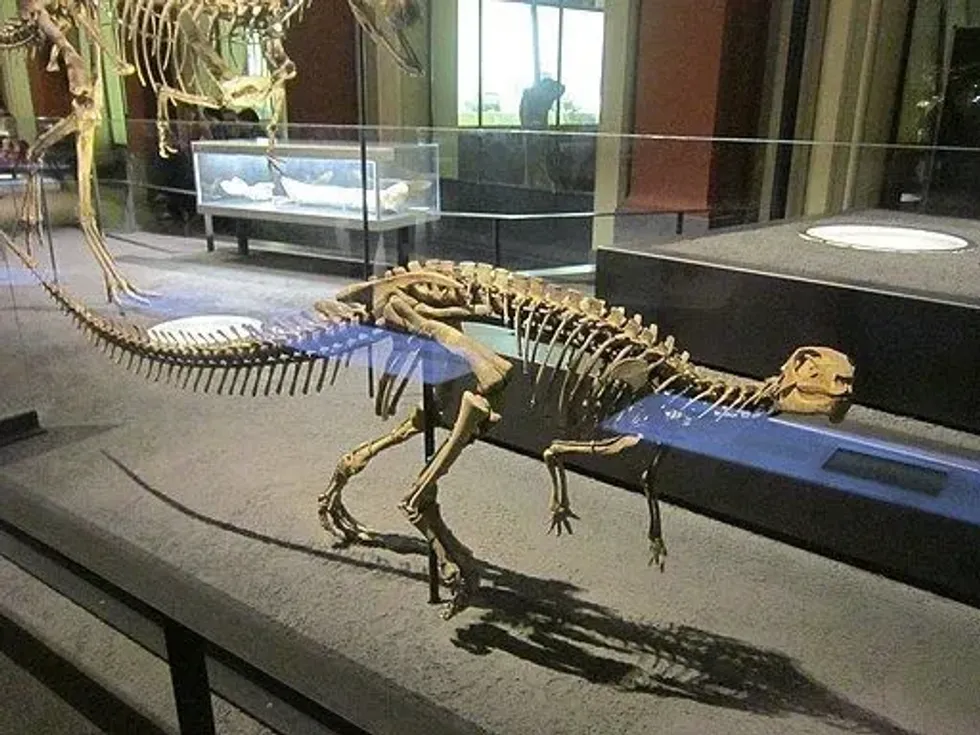The kangaroo rat is a group of nocturnal rodents, consisting of 20 species. They are native to northwestern America. They received their name from their ability to hop like a kangaroo using their hind legs.
Their long hind legs with four toes and a long tail to balance are the reason for their speed. A kangaroo rat's cheek pouch is one of its special attributes. They can store seeds in their cheek pouches.
They live in arid and semi-arid areas, mostly in deserts. Kangaroo rats drink water only when it is extremely required. They can fulfill their need for water by extracting it from the seeds. Their diet includes seeds, berries, nuts, green vegetation, and small insects as well.
A desert Kangaroo rat can adapt to life in the desert. A desert Kangaroo rat has extreme hearing abilities. They can even detect the movement of an owl!
To learn more, we have collected a set of interesting pieces of information about this fascinating creature for you to read. You can also learn more by reading more articles on the elephant shrew or the snowshoe hare.
Kangaroo Rat Interesting Facts
What type of animal is a kangaroo rat?
Kangaroo rats are a group of omnivorous nocturnal rodents with 20 identified species, living mostly in desert ranges.
What class of animal does a kangaroo rat belong to?
Kangaroo rats belong to the Mammalia class and Heteromyidae family.
How many kangaroo rats are there in the world?
The estimated range of their extant habitat is 27540 acres (11,145 ha) and their estimated density range is 25-375 rats per acre.
Where does a kangaroo rat live?
Kangaroo rats live in arid and semi-arid areas of northwestern America. They prefer sandy or soft soils, suitable for burrowing. However, different species have their own habitat preferences.
What is a kangaroo rat's habitat?
A kangaroo rat habitat includes arid and semi-arid soils. They prefer dry habitats such as chaparral and sagebrush, mixed grass, desert grassland, and scrubland.
Their habitat preference may change in different geographic locations. Their elevation, choice of weather, and soul range vary from species to species.
For example, Merriam's kangaroo rats prefer areas with low rainfall and humidity along with high summer temperatures and evaporation rates. Banner-tailed kangaroo rats prefer soils that are soft in nature and grasslands, on the other hand, there are species that prefer hard, stony soils with clay.
They live in burrows that may contain separate chambers for sleeping, breeding, and storing food. They cannot withstand extreme temperatures and heavy rains, therefore, they take shelter in burrows. They spend most of the day sleeping and come out in the dark when the temperature goes down.
Who do kangaroo rats live with?
Kangaroo rats live a solitary life with individual territories of 200-300 ft (61 - 91.4 m). They use the feet drumming technique to announce their territory. They are aggressive and do not hesitate to engage in a brawl with other males to protect their territory. They occasionally gather in groups of hundreds and form colonies.
How long does a kangaroo rat live?
These adorable little creatures unfortunately don't live very long. They have a two to five year lifespan on average. They can survive for up to eight years under perfect circumstances.
How do they reproduce?
Kangaroo rats often mate with different partners. There is no definitive courtship period because of their aggressive nature.
The only time they halt their aggressive behavior is during a brief precopulatory period. Kangaroo rats are very competitive when it comes to mating. They form and follow a hierarchy for access to females.
The ideal mating season for kangaroo rats is in summer, followed by monsoon. It has been observed that they can adapt to the local climate and put efforts into reproduction accordingly. Before engaging, the male and the female kangaroo rat perform nasal-anal circling until the female allows the male to mount her.
To ensure a better success rate, a female Merriam's kangaroo rat may allow multiple males to mount her within a brief period. Banner-tailed kangaroo rats chase away the rival males and mate on mounds.
The range of their gestation period is 22-27 days. They give birth in a fur-lined nest in the burrows. In the second or third weak week, the young develop their hind legs and become independent.
What is their conservation status?
Most species of kangaroo rats are listed as Non Extinct species. However, the Stephens' kangaroo rat was listed as an Endangered Species in 1988. They lost half of their habitat due to industrial development.
Kangaroo Rat Fun Facts
What do kangaroo rats look like?

Kangaroo rats have a large skull with big eyes for clearer vision in the dark and small ears. The big-eared kangaroo rat (Dipodomys elephantinus) has larger ears than any other species in their group.
Kangaroo rats have fur-lined cheek pockets to store food. They have strong hind legs, which helps them to jump long distances. These hind feet are also responsible for their great speed.
Their tail is longer than their body and covered with fur. Their tail is tufted with white at the top. Their color varies from species to species.
They are usually of cinnamon buff, dark grey, dark brown, and sandy brown color. Sexual dimorphism exists in their group as well, where females are comparatively smaller in size than male rats.
How cute are they?
Kangaroo rats are incredibly adorable creatures. Their glossy button-like eyes have the power to steal anyone's heart!
How do they communicate?
They use the foot drumming method and scent marks to communicate with others. Kangaroo rats lead a solitary life with little or no social interaction. However, they form colonies in crisis or complex feeding situations. Female rats are comparatively less aggressive than males. Male rats possess a superiority complex and they display dominating nature in front of female ones.
How big is a kangaroo rat?
An average kangaroo rat is 3.1-5.5 in (8-14 cm) length, with a tail length of 5.5-6.3 in (14-16 cm). The giant kangaroo rat (Dipodomys ingens) is the largest of them all with a body length of 5.9-7.9 in (15-20 cm).
How fast can a kangaroo rat run?
They are one of the quickest in their family. They can run at a speed of 6 mph (9.7 kph) and can jump up to 7 ft (2.1 m).
Not only they are fast but they can change direction with ease while running at top speed. This is made possible by the strength of the hind legs and the use of their tail to balance. They are called 'spring-loaded ninjas' for a reason!
How much does a kangaroo rat weigh?
Kangaroo rats can weigh from 2.5-6 oz (70-170 g) depending on their diet. The giant kangaroo rat (Dipodomys ingens) is the heaviest of all of them and can weigh up to 6.9 oz (195 g).
What are their male and female names of the species?
There are designated names for male and female rats. Males are termed bucks, while parent females are called dams. However unmated females are referred to as does. Since kangaroo rats, the plural noun for them is mischief.
What would you call a baby kangaroo rat?
Baby kangaroo rats are called pups.
What do they eat?
The kangaroo rat is an omnivorous animal. The main components of the kangaroo rat's food are berries and seeds.
Additionally, they eat tubers, greenery, and sporadically tiny insects. Typically, they don't eat succulent vegetation found in the desert. California kangaroo rats prefer manzanita berries in the fall and green vegetation in spring.
They bury and store their food near their burrows or inside their burrows if it has a separate chamber for food. They can also store seeds in their cheek pouches and the extras in seed caches.
Merriam's kangaroo rats hide small caches of seeds in different locations. Drinking too much water can affect their health. Desert kangaroo rats consume a very limited amount of water in a year.
If they drink more than they need, it can flush away all the nutrients out of their body and can be fatal for them. They fulfill their need for water by extracting it from the seeds they eat.
Are they aggressive?
Male kangaroo rats are more aggressive than female ones. They can brawl with each other over territory, food, and courtship. They perform foot drumming with their hind legs to signal to their rivals to stay away!
Would they make a good pet?
The answer is a big no. First of all, it is illegal to own a kangaroo rat. They require specific temperatures and humidity to live. These rodents also carry diseases, making them dangerous for humans. So it is for the betterment of everyone to abandon the thought of having them as a pet.
Did you know...
Kangaroo rats' predators are foxes, snakes, hawks, owls, bobcats, and coyotes. Snakes are considered the deadliest for them.
The giant kangaroo rat was declared an Endangered species when it lost nearly 98% of its habitat due to the industrial revolution and modification of its habitat for agricultural purposes.
A species of kangaroo rats, Dipodomys merriami, or Merriam's kangaroo rat, can survive an ambush by a rattlesnake.
Gulf Coast kangaroo rats have the palest skin color out of all from this genus.
A desert kangaroo rat lives in the aridest soils of north America. The scorching heat of the desert is the ideal condition for them to live. They can adapt to desert life with ease.
A desert kangaroo rat is the main prey of snakes in the desert.
They can restrict their movement outside burrows to ensure limited and controlled consumption of energy and water. It also protects them from their predators.
Kangaroo rats can aerate the desert soil with their extensive networks of burrows.
How do the kangaroo rat's eyes help?
Kangaroo rats are nocturnal animals. They possess a pair of big eyes, which helps them to see clearly in the dark. It is an essential tool for them to avoid attacks from their predators.
How do kangaroo rats conserve water?
Karoo rats can go for months without drinking water. They can extract the amount of water they need from the seeds.
They can extract 0.017 oz (0.5 g) of water from 0.035 oz (1 g) of seeds consumed. Their kidneys can reduce their urine to such an extent that it almost crystallizes and restricts the water loss in the process.
They can also condense moisture in their nasal passages and as nocturnal animals, they lose a much lesser amount of water through sweating, compared to others.
Here at Kidadl, we have carefully created lots of interesting family-friendly animal facts for everyone to discover! Learn more about some other mammals including muskrats and the African civet.
You can even occupy yourself at home by drawing one of our Kangaroo rat coloring pages.










